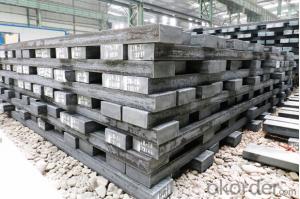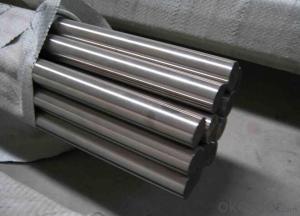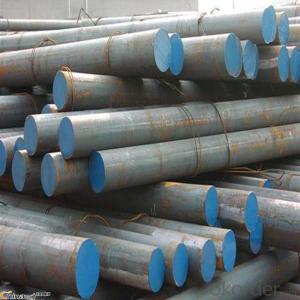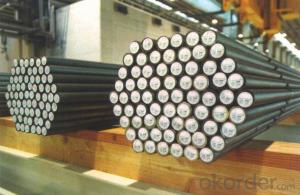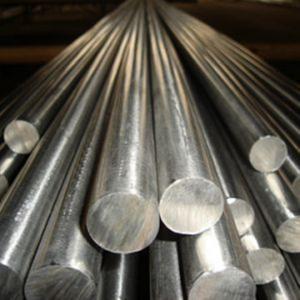Grade 4340 (ASTM A29) Alloy Special Steel Round Bar
- Loading Port:
- Shanghai
- Payment Terms:
- TT OR LC
- Min Order Qty:
- 30 m.t
- Supply Capability:
- 10000 m.t/month
OKorder Service Pledge
OKorder Financial Service
You Might Also Like
Specification
Specifications of Round Bar
1. Alloy steel round bar
2. Dia:16mm~250mm
3. Length: 6m, 9m, 12m or as customer’s request
4. Tolerance: Within ±5% for weight; ±2mm for diameter
5. Note: The price can be better is the quantity is good
Equivement Grade
DIN:34CRNIMO
SAE:4340
JIS:SNCM439(SNCM8)
BS:817M40
UNI:40NiCrMo7
Chemical Composition
C | Si | Mn | S | P | Cr | Ni | Cu | Mo |
0.37-0.44 | 0.17-0.37 | 0.50-0.80 | ≤0.025 | ≤0.025 | 0.60-0.90 | 1.25-1.65 | ≤0.025 | 0.15-0.25 |
Our Featured Products
Alloy steel: Combination of steel / Bearing steel// Spring steel/ Cr- mo steel
GB 20Cr/ 40Cr / 42CrMo / 35CrMo/ 20CrMn/GCr15/30CrMnTi…
ASTM 5120 /5140 / 4140/ 4135/ 5152/52100…
JIS SCr420H/ SCr440/ SCM3/ SUP9/SUJ2…
Carbon steel: Carbon tool steel /Carbon Structural Steel
GB 20/ 35 /45/…
ASTM 1020/ 1030/1045…
JIS S20C/ S30C / S45C…
Usage and Applications of Round Bar
1. Chinese standard steel bar is often used where large amounts of steel need to be formed, for example as structural steel.
2. And we can use this kind of product on the performance of the mechanical parts if the demand is not very high.
3. Steel round bar is used in construction and a large number of architectural and engineering structures.
Packaging & Delivery of Round Bar
Packaging Detail: All goods are packed in bundle with steel strips and shipped by break bulk vessel or container (depend on target market and different ports)
Delivery Detail: 15~45 days
Trade terms: FOB, CFR, CIF
MOQ: 30 metric tons per specification; we can negotiate the quantity if the specification is normal or we have stock of one specification.
Weight: Theprice invoicing on theoretical weight basis or actual weight basis depends on customer’s request.
Shipment: The shipment of bulk break or container is depends on customer’s request and the situation of the port of destination.
Documents given: Full set of original clean on board bill of lading; Original signed commercial invoice; Original packing list; Policy of insurance; Certificate of origin and what the target market needs.
Production Flow of Round Bar
1. The common processes are preheated forging quenching, dual refinement solution process, cooling quenching and isothermal quenching. We use heat treatment for dual refinement solution process.
2. Material prepare (billet) — heat up — rough rolling — precision rolling — cooling — packing — storage and transportation
FAQ:
Q1: Why buy Materials & Equipment from OKorder.com?
A1: All products offered byOKorder.com are carefully selected from China's most reliable manufacturing enterprises. Through its ISO certifications, OKorder.com adheres to the highest standards and a commitment to supply chain safety and customer satisfaction.
Q2: How do we guarantee the quality of our products?
A2: We have established an advanced quality management system which conducts strict quality tests at every step, from raw materials to the final product. At the same time, we provide extensive follow-up service assurances as required.
Q3: How soon can we receive the product after purchase?
A3: Within three days of placing an order, we will begin production. The specific shipping date is dependent upon international and government factors, but is typically 7 to 10 workdays.
Q4: What makes stainless steel stainless?
A4: Stainless steel must contain at least 10.5 % chromium. It is this element that reacts with the oxygen in the air to form a complex chrome-oxide surface layer that is invisible but strong enough to prevent further oxygen from "staining" (rusting) the surface. Higher levels of chromium and the addition of other alloying elements such as nickel and molybdenum enhance this surface layer and improve the corrosion resistance of the stainless material.
Q5: Can stainless steel rust?
A5: Stainless does not "rust" as you think of regular steel rusting with a red oxide on the surface that flakes off. If you see red rust it is probably due to some iron particles that have contaminated the surface of the stainless steel and it is these iron particles that are rusting. Look at the source of the rusting and see if you can remove it from the surface.


- Q: How does wear-resistant steel protect against abrasive wear?
- Wear-resistant steel protects against abrasive wear by having a high hardness and toughness, which enables it to withstand the constant rubbing and grinding action of abrasive materials. The steel's resistance to deformation and ability to retain its shape under pressure prevent the abrasive particles from causing significant damage, thereby extending the lifespan of the material.
- Q: What are the main applications of special steel in the power distribution industry?
- Special steel is widely used in the power distribution industry for various applications. One of the main applications is in the construction of transmission towers and electrical pylons. Special steel is preferred for these structures due to its high strength, durability, and resistance to corrosion. It ensures the safe and reliable transmission of electricity over long distances. Special steel is also used in the manufacturing of electrical transformers and generators. The steel's magnetic properties make it suitable for creating efficient and reliable power generation and distribution equipment. Additionally, special steel is used in the production of electrical connectors and conductors, which are essential for ensuring the efficient flow of electricity through power distribution systems. Overall, the main applications of special steel in the power distribution industry include transmission towers, electrical pylons, transformers, generators, and electrical connectors. These applications play a crucial role in maintaining a robust and reliable power grid, ensuring uninterrupted electricity supply to consumers.
- Q: Can special steel be used for tooling applications?
- Yes, special steel can be used for tooling applications. Special steels, such as high-speed steels and tool steels, are specifically designed and manufactured to have superior properties for tooling purposes. These steels possess characteristics such as high hardness, wear resistance, toughness, and heat resistance, making them ideal for tooling applications where durability and performance are crucial.
- Q: How does special steel perform in construction applications?
- With its exceptional properties and performance characteristics, special steel, also known as alloy steel, plays a vital role in construction applications. Its enhanced strength, durability, and resistance to environmental factors make it highly suitable for demanding projects. A major advantage of special steel in construction is its high strength-to-weight ratio. This means it can handle heavy loads and pressures while remaining relatively lightweight, allowing for more efficient and cost-effective designs. Additionally, special steel has excellent fracture toughness, ensuring that structures built with this material can withstand significant impacts and vibrations without failure. Another significant benefit is its exceptional corrosion resistance. Construction projects often face exposure to harsh weather conditions, chemicals, and moisture, which can cause rusting and deterioration of traditional steel. However, special steel contains elements like chromium, nickel, and molybdenum, which provide excellent resistance to corrosion and oxidation, ensuring the longevity and durability of structures. Furthermore, special steel offers excellent weldability, enabling the efficient and secure joining of various components during construction. This allows for the fabrication of complex structures while maintaining their integrity and strength. In addition to its mechanical properties, special steel can provide additional benefits in construction applications. For instance, certain types of special steel possess excellent fire resistance, making them ideal for constructing fire-resistant structures or components. Additionally, some types of special steel offer enhanced electrical conductivity, making them suitable for applications that require efficient transmission of electricity. Overall, special steel's superior strength, durability, corrosion resistance, weldability, and additional properties make it an excellent choice for a wide range of construction applications. Whether it's high-rise buildings, bridges, infrastructure, offshore structures, or industrial facilities, special steel ensures the construction of safe, reliable, and long-lasting structures in challenging environments.
- Q: What are the different methods for improving the corrosion resistance of special steel?
- There are various methods for improving the corrosion resistance of special steel. One common approach is the addition of alloying elements such as chromium, nickel, and molybdenum, which form a protective oxide layer on the steel's surface. Surface treatments like galvanizing, electroplating, or applying protective coatings can also enhance corrosion resistance. Additionally, heat treatment processes like annealing, quenching, and tempering can modify the microstructure of the steel, making it more resistant to corrosion. Regular maintenance, including proper cleaning and lubrication, is also important in preventing corrosion and preserving the steel's integrity.
- Q: What are the different international standards for special steel?
- There are several international standards for special steel, including the American Society for Testing and Materials (ASTM) standards, the International Organization for Standardization (ISO) standards, and the European Standards (EN) standards. These standards define the chemical composition, mechanical properties, and testing requirements for various types of special steel, ensuring quality and consistency in their production and usage worldwide.
- Q: What are the common techniques for testing the quality of special steel?
- Some common techniques for testing the quality of special steel include chemical analysis, mechanical testing, non-destructive testing, and metallography. Chemical analysis involves examining the composition of the steel to ensure it meets the required specifications. Mechanical testing involves subjecting the steel to various forces and measuring its strength, hardness, and other mechanical properties. Non-destructive testing methods such as ultrasound, radiography, and magnetic particle inspection are used to detect any defects or flaws in the steel without causing damage. Metallography involves examining the microstructure of the steel under a microscope to assess its grain size, inclusion content, and overall quality. These techniques help ensure that special steel meets the necessary standards and requirements.
- Q: How does special steel contribute to the manufacturing of hydraulic components?
- Due to its unique properties and characteristics, special steel plays a vital role in the manufacturing of hydraulic components. These components, including cylinders, pumps, valves, and fittings, operate under extreme conditions and high pressure. Therefore, they require materials capable of withstanding such demanding environments. Special steel, also referred to as alloy steel, is specifically designed to possess exceptional strength, durability, and resistance to corrosion and wear. These qualities make it an ideal material for hydraulic components, as they must endure high pressures, continuous movement, and exposure to various fluids. The impressive strength of special steel allows hydraulic components to handle heavy loads and resist deformation, ensuring their long-term reliability and performance. Furthermore, the durability of special steel ensures that hydraulic components can withstand continuous stress and movement without experiencing premature failures. An additional significant advantage of special steel is its resistance to corrosion and wear. Hydraulic components often come into contact with different fluids, such as water, oil, and chemicals. The corrosion resistance of special steel protects the components from degradation and extends their lifespan. Moreover, its resistance to wear minimizes the damage caused by friction, resulting in smooth operation and reduced maintenance requirements. Furthermore, special steel is easily machinable and can be formed into complex shapes. This versatility enables the production of intricate hydraulic components with precise specifications. Manufacturers can tailor these components to meet the specific requirements of different hydraulic systems, ensuring optimal performance and efficiency. In conclusion, special steel significantly contributes to the manufacturing of hydraulic components by providing the necessary strength, durability, corrosion resistance, and wear resistance. Its unique properties enable the production of high-quality and reliable hydraulic components that can withstand demanding environments and ensure the smooth operation of hydraulic systems.
- Q: What is the role of research and development in advancing special steel technology?
- The advancement of special steel technology relies heavily on research and development (R&D). Special steel, which refers to steel alloys with enhanced properties like high strength, corrosion resistance, heat resistance, or electrical conductivity, benefits greatly from R&D efforts. R&D activities are crucial for pushing the boundaries of special steel technology and creating new and improved alloys. Scientists and engineers continuously research and explore new compositions, manufacturing processes, and heat treatment techniques to enhance the properties and performance of special steels. One of the primary roles of R&D in advancing special steel technology involves discovering and developing new alloy compositions. R&D teams analyze the properties of different elements and their interactions to design steel alloys with desired characteristics. Through experiments and testing, they optimize the alloy to meet specific application requirements and enhance properties like strength, hardness, toughness, or other desirable traits. Additionally, R&D focuses on developing innovative manufacturing processes for special steel production. Techniques such as vacuum melting, rapid solidification, or powder metallurgy are employed to achieve a refined microstructure and improved mechanical properties. R&D teams work on optimizing these processes to enhance the overall quality, efficiency, and cost-effectiveness of special steel production. R&D also plays a crucial role in improving heat treatment techniques for special steels. Heat treatment is a critical step in fabricating special steels as it helps achieve desired microstructures and properties. R&D endeavors to optimize heat treatment parameters like temperature, time, and cooling rates to enhance the mechanical properties and performance of special steels. Furthermore, R&D contributes to the development of new testing and characterization methods for special steels. This enables the evaluation and validation of properties and performance under various conditions. Advanced techniques like electron microscopy, X-ray diffraction, and mechanical testing are employed to assess microstructural features, phase transformations, and mechanical behavior. Overall, R&D activities are indispensable for advancing special steel technology. Through continuous research, innovation, and optimization, R&D teams contribute to the development of new and improved alloys, manufacturing processes, heat treatment techniques, and testing methods. This ultimately leads to the advancement of special steel technology and its applications in industries like automotive, aerospace, energy, and construction.
- Q: Can special steel be used in the defense industry?
- Yes, special steel can be used in the defense industry. Special steel, such as high-strength steel or armor-grade steel, possesses unique properties that make it suitable for various defense applications. It can be used for manufacturing military vehicles, aircraft components, body armor, ballistic plates, and other defense equipment that require enhanced strength, durability, and resistance to extreme conditions. Special steel's ability to withstand impacts, provide protection against projectiles, and maintain structural integrity makes it an essential material in the defense industry.
Send your message to us
Grade 4340 (ASTM A29) Alloy Special Steel Round Bar
- Loading Port:
- Shanghai
- Payment Terms:
- TT OR LC
- Min Order Qty:
- 30 m.t
- Supply Capability:
- 10000 m.t/month
OKorder Service Pledge
OKorder Financial Service
Similar products
Hot products
Hot Searches
Related keywords












